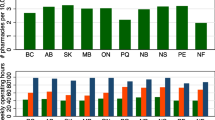Abstract
Community pharmacies play an important role in maintaining population health in the United States. They are large in number, distribute widely across geographic areas, and operate for long hours. Because the elderly population tends to use more medications and have more frequent interaction with pharmacies and pharmacists, this study was carried out to understand the geographic access to community pharmacies by the elderly in Illinois and to estimate the disparity in the access between rural and urban areas. The addresses of all community pharmacies operating in 2001 were geocoded to identify their locations. The Census 2000 data on demographics at the census block group level was used to estimate the geographic distribution of the Illinois population by age group. Using the centroid of each census block group and the locations of community pharmacies, the distance to a nearest pharmacy for each census block group was calculated. The distance was then weighted to compute the aggregated distance required for the elderly to access a pharmacy. There were 1373 community pharmacies operating in Illinois in 2001. Most pharmacies (93.8%) were located in urban areas. On average, there were 1.27 and 0.38 pharmacies per 10,000 people in urban and rural areas, respectively. The average distance for an elderly person in Illinois to locate a community pharmacy was 0.9 miles in urban areas, but it was six times more (5.9 miles) in rural areas. At least 10% of the rural elderly had to travel more than 11.8 miles to find a community pharmacy, but only 0.1% had to travel more than 20 miles. The geographic access to community pharmacies appears to be appropriate in Illinois. However, a small portion of rural elderly who do not have a pharmacy in their nearby areas may warrant special attention.
Similar content being viewed by others
REFERENCES
Knapp, K. K., Paavola, F. G., Maine, L. L., Sorofman, B., and Politzer, R. M., Availability of primary care providers and pharmacists in the United States. J. Am. Pharm. Assoc. (Wash.) 39:127-135, 1999.
Doucette, W. R., Brooks, J. M., Sorofman, B. A., and Wong, H., Market factors and the availability of community pharmacies. Clin. Ther. 21:1267-1279, 1999.
Office of Inspector General, The Clinical Role of the Community Pharmacist, DHHS, Washington, DC, 1990.
Mitchell, R., Dorling, D., and Shaw, M., Population production and modeling mortality―an application of geographic information systems in health inequalities research. Health Place 8:15-24, 2002.
U.S. Census Bureau, Cartographic Boundary Files. Retrieved October 10, 2003, from http://www.census.gov/geo/www/cob/bg_metadata.html
U.S. Census Bureau, Census 2000 Urban and Rural Classification. Retrieved October 10, 2003, from http://www.census.gov/geo/www/ua/ua_2k.html
Department of Health & Human Services, Prescription Drug Coverage, Spending, Utilization, and Prices, Department of Health & Human Services, Washington, DC, 2000.
Families, USA Foundation, Bitter Pill: The Rising Prices of Prescriptions for Older Americans, Families USA Foundation, Washington, DC, 2002.
Beers, M. H., Ouslander, J. G., Fingold, S. F., Morgenstern, H., Reuben, D. B., Rogers, W., Zeffren, M. J., and Beck, J. C., Inappropriate medication prescribing in skilled-nursing facilities. Ann. Intern. Med. 117:684-689, 1992.
Hanlon, J. T., Schmader, K. E., Boult, C., Artz, M. B., Gross, C. R., Fillenbaum, G. G., Ruby, C. M., and Garrard, J. Use of inappropriate prescription drugs by older people. J. Am. Geriatr. Soc. 50:26-34, 2002.
Pimlott, N. J., Hux, J. E., Wilson, L. M., Kahan, M., Li, C., and Rosser, W. W., Educating physicians to reduce benzodiazepine use by elderly patients: A randomized controlled trial. CMAJ 168:835-839, 2003.
Elliott, R. A., Woodward, M. C., and Oborne, C. A., Improving benzodiazepine prescribing for elderly hospital inpatients using audit and multidisciplinary feedback. Intern. Med. J. 31:529-535, 2001.
Monane, M., Matthias, D. M., Nagle, B. A., and Kelly, M. A., Improving prescribing patterns for the elderly through an online drug utilization review intervention: A system linking the physician, pharmacist, and computer. JAMA 280:1249-1252, 1998.
Hanlon, J. T., Weinberger, M., Samsa, G. P., Schmader, K. E., Uttech, K. M., Lewis, I. K., Cowper, P. A., Landsman, P. B., Cohen, H. J., and Feussner, J. R. A randomized, controlled trial of a clinical pharmacist intervention to improve inappropriate prescribing in elderly outpatients with polypharmacy. Am. J. Med. 100:428-437, 1996.
Lipton, H. L., Bero, L. A., Bird, J. A., and McPhee, S. J., The impact of clinical pharmacists' consultations on physicians' geriatric drug prescribing. A randomized controlled trial. Med. Care 30:646-658, 1992.
Medicare Payment Advisory Commission, A Data Book: Healthcare Spending and the Medicare Program, Medicare Payment Advisory Commission, Washington, DC, 2003.
Casey, M., Klingner, J., and Moscovice, I., Pharmacy services in rural areas: is the problem geographic access or financial access? J. Rural Health 18:467-477, 2002.
Stuart, B., Shea, D., and Briesacher, B., Dynamics in drug coverage of Medicare beneficiaries: Finders, losers, switchers. Health Affairs 20:86-99, 2001.
Ricketts, T. I., Rural Health in the United States, Oxford University Press, New York, 1999.
Straub, L. A., and Holmes, M., Access to pharmacy services in rural Illinois. Rural Res. Rep. 8:1-8, 1997.
Frisch, L., Kellerman, R., and Ast, T., A cohort study of family practice residency graduates in a predominantly rural state: initial practice site selection and trajectories of practice movement. J. Rural Health 19:47-54, 2003.
Dalton, K., Slifkin, R. T., and Howard, H. A., Rural hospital wages and the area wage index. Health Care Fin. Rev. 24:155-175, 2002.
U.S. Department of Agriculture, Measuring Rurality: New Definitions in 2003, Economic Research Service, U.S. Department of Agriculture, 2003. Retrieved October 20, 2003, from http:// www.ers.usda.gov/Briefing/Rurality/Newdefinitions/
Author information
Authors and Affiliations
Rights and permissions
About this article
Cite this article
Lin, SJ. Access to Community Pharmacies by the Elderly in Illinois: A Geographic Information Systems Analysis. Journal of Medical Systems 28, 301–309 (2004). https://doi.org/10.1023/B:JOMS.0000032846.20676.94
Issue Date:
DOI: https://doi.org/10.1023/B:JOMS.0000032846.20676.94




